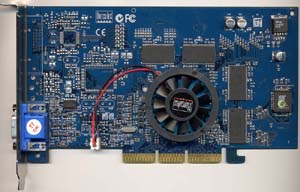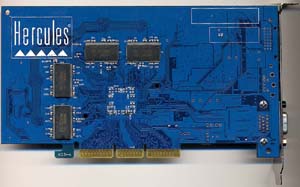The Card
As mentioned before, the result of STMicroelectronics' partnership with Hercules/Guillemot is the 3D Prophet 4500. The card, which is shown here in prerelease form, is expected to change only in board layout by the time it hits market. Our prerelease card is a modified STMicro reference design will most likely be shrunk by the time the product hits shelves.
Judging by size of the chip, the Kyro II graphics processor is rather small, although no die sizes have been given out by STMicroelectronics. This is no surprise since the Kyro II features a mere 15 million transistors, compared to the 25 million transistor GeForce2 GTS.
On the 3D Prophet 4500, the Kyro II core is cooled by a blue circular heatsink/fan, reminiscent of the Blue Orb. As we mentioned previously, the Kyro II only dissipates 4 watts of heat, placing it at the heat level of the GeForce2 MX, a chip that we have seen run not only without out a fan but without cooling of any sorts. Hercules/Guillemot claims that the heatsink/fan, which is bonded to the core via thermal tape, is necessary to get the chip up to the 175 MHz speed it will be selling at with the 3D Prophet 4500. If this really is the case, expect competing Kyro II products to feature only a heatsink or no cooling at all with a core clock running at 166 MHz.
The pre-production card we had featured 64MB of memory, as this is the only configuration the 3D Prophet 4500 will be sold in. We have seen in the past that the jump from 32MB to 64MB of video memory makes very little to no difference in real game performance, although it can come in handy in texture heavy situations. It is most likely the case that Hercules/Guillemot choose to go with 64MB of memory simply as a selling point: many users who see a 64MB card on the shelf right next to a 32MB one will assume that the one with more memory is better.
The memory on our board was contained in eight, 8MB Hyundai SDR SDRAM chips rated at 5.0 ns. This means that the chips are rated up to 200 MHz, well above the 175 MHz clock speed that the memory operates on. As production begins to ramp up, it will not be surprising to see these 5.0 ns chips replaced with 5.5 ns ones, given that the yields on 5.5 ns memory are good.
The front of the board reveals two silk screens for chips not placed on our board. The first, smaller silk-screen is for placement of a Silicon Image TMDS controller for flat panel support. The Kyro II does not feature an internal TMDS, so flat panel support had to be provided by a third party manufacturer.
The second, larger silk-screen, located more centrally, is for a Chrontel video-out chip. The board will also be sold with optional video-out that will include this Chrontel chip as well as S-video and composite-out ports.
Pricing for the board is very competitive, with the base 3D Prophet 4500, sold with 64MB of memory, coming in at a suggested retail price of $149.99. The same card with TV-out is slated to cost $20 more, bringing the price of the card up to $169.99.
With what Hercules/Guillemot promises will be extreme performance, which we will look at for ourselves in a moment, one has to wonder if the company is starting to compete with themselves. As mentioned before, Hercules/Guillemot is the 2nd largest producer of NVIDIA based cards. As it stands now, their very popular 3D Prophet II MX is priced at around $100 and the 3D Prophet II GTS is now around $230. Falling between these two price points, the base 3D Prophet 4500 gets dangerously close to the 3D Prophet II MX's price range. Hercules/Guillemot said they did not see a problem with this, as "There is nothing like it [the 3D Prophet 4500] for its price." As the card prices drop, we do expect Hercules/Guillemot to move more away from their powerful GeForce2 MX line, replacing it with the Kyro II based 4500. This will be especially true as the 3D Prophet II 4000, based on the original Kyro, begins to hit shelves at around $79.
Lastly, we imagine that many of you are wondering about the name, as we sure did. Does the 3D Prophet 4500 sound reminiscent of another recently released board? Perhaps the Voodoo4 4500 comes to mind. Well, we asked Hercules/Guillemot about this and the tongue in cheek response was that 4500 was actually STMicroelectronic's internal code name for the Kyro II. True or not, we believe there is a bit more to the name than just that, although we are puzzled why any company would want to name an item after a product that ultimately failed.












4 Comments
View All Comments
MonkeyPaw - Monday, February 24, 2014 - link
Thanks for the stroll down memory lane (by keeping the article up). I had one of these cards back in 2002, and it was one I looked back upon fondly. I can't remember most of the GPUs I owned from yesteryear, save the Voodoo 3 and the crappy S3 Verge. That's fairly elite company, at least in my brain, anyway. :)xrror - Monday, March 2, 2015 - link
Yea, it's sad that there wasn't any further development of the Kyro series in the PC market. If I remember right (probably needs fact checked) Imagination's development resources got sucked into the Sega Dreamcast after this point. Even that wouldn't have been so bad if Sega hadn't just given up on the Dreamcast so early on due to a "poor showing in Japan" (nevermind everyone loved it in the US but we didn't count apparently, also see Genesis/MegaDrive).I think Imagination or at least their tech lives on in the embedded/mobile space now, but meh - really wanted to see what they could have done with their tech without being shackled to a power budget in 2002-2005 era PC's.
Alexvrb - Wednesday, October 14, 2020 - link
You're wrong. The Dreamcast was designed years earlier using PowerVR Series 2. The later "Kyro series" was based on Series 3. The DC design win netted them some much needed cash which they used to fuel their Series 3 releases. What killed imgtech was their inability to play well with others (board partners) and issues staying on schedule for releases. If they had managed to get the 4800 out the door sooner, and released the larger Kyro III with DDR it would have bought them some time. Especially if they had paired it with a hardware T&L block like Elan.thegreatjombi - Wednesday, August 12, 2015 - link
Its very interesting to think that Imagination Technologies could have been another foot note in history (3dfx, bitboys Oy! Rendition..) but going mobile and refining their technology has allowed them to basically become more popular than ATI(AMD) or Nvidia. There are probably more devices in peoples houses running a powervr variant than have an AMD or Nvidia GPU.I do wish someone would stick their chip on a discrete card again, they apparently support full Directx and OpenGL! could be an interesting low profile, low end, low power, fanless card for HTPCs.